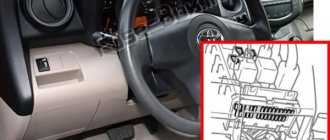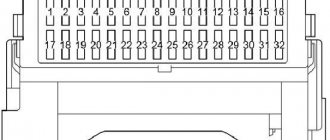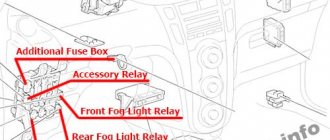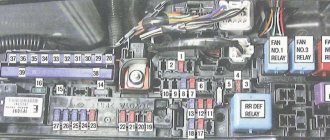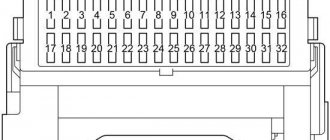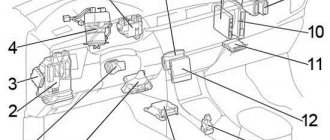Photo: Anton Vlasov
The history of the RAV4 began five years before the official debut of the model, which happened in 1994. At the 1989 Tokyo Motor Show, Toyota Motor Corporation presented an interesting concept called the RAV Four: a compact 3-door all-terrain vehicle designed in a youth style. Actually, it is these qualities that will later become the basic values that the manufacturer will put into the serial implementation of the prototype. The unusual show car attracted a lot of attention, and Toyota management gave the green light to the creation of the first generation crossover.
| RAV Four | ||
Finally, in 1994, the production RAV4 debuted, the appearance of which became, if not a sensation, then certainly a landmark event. And not only for Toyota, but for the entire automotive industry in general - many theorists believe that the RAV4 was the first crossover that combined moderately small dimensions, a decent level of comfort, easy handling, attractive design and increased cross-country ability. And although in reality Toyota’s new product was not a pioneer, the Japanese company managed to create a truly popular, and therefore mass-produced car of this then nascent class. The unusual car quickly became popular, proving the success of the concept: the manufacturer expected to sell 4,200 cars monthly, but in the first month 8,000 were sold! Initially, the RAV4 was produced in a three-door body, but a year and a half after the start of production, a five-door modification was also introduced.
First generation RAV4
The abbreviation RAV stands for Recreational Active Vehicle ("vehicle for active recreation"), and the number 4 means the presence of permanent all-wheel drive. And although over the years the idea of the model changed significantly, which was reflected in a shift in the set of qualities towards family values, as well as the loss of the AWD system along the way, the first generation car fully corresponded to the ideas of the engineers and designers. The fact that the car was built on the platform of the all-wheel drive modification of the Celica GT-Four coupe says a lot.
Toyota Celica GT-Four
Over the years of the series' existence, several generations of the model have changed: the RAV4 has gained in size and weight, acquired several engine options (the original 1994 unit had only one two-liter engine - albeit with different degrees of boost), received as many as three types of transmission to choose from, but lost the three-door body and finally registered in the city. The 2021 model car is already the fourth variation of the RAV4. Although, perhaps, it would be correct to call the modern crossover version 4.5, since the car was updated by the beginning of this year. Wide enough to add .5 to the generation number, but not deep enough to raise it to the next whole number.
⇡#Exterior
The full list of modifications implemented in the latest generation RAV4 is impressive - the manufacturer has refined and redesigned a lot. And the most noticeable innovation is the updated design of the car.
The 2021 crossover received new LED slanted headlights, the area of which is now slightly smaller than that of the pre-restyling version. There is also a modified design of the radiator grille, and indeed the entire front part of the car.
The practical but not particularly elegant unpainted bumpers of the fourth-generation model have given way to painted parts. Or rather, if we talk about the rear bumper, only the upper half is painted, while the lower part of the bumper is still matte. On the one hand, such a combined solution added gloss to the Japanese crossover and made the rear design more elegant, and on the other hand, it complicated the process of loading the trunk, since if you need to transport something large and heavy in the car, you will now have to be careful not to scratch the varnished element. The 2021 model also received updated rear optics.
The belt of the lower matte overlays goes around the entire car - even from the doors. These wide shields made of unpainted plastic effectively protect the sills from dirt even in wet weather, which means that your trouser legs will also be clean if you suddenly get into the car carelessly.
The manufacturer abandoned a full-fledged spare wheel in favor of the so-called “dokatka”, and therefore the volume of the cargo compartment has increased by a respectable 68 liters and now amounts to 577 liters. With a flat floor, low loading height, and the ability to quickly and easily fold the second-row seats, the RAV4 can carry really large items.
In addition to the emergency wheel, hidden underground is a standard cargo securing system using a net, which is convenient for securing “particularly mobile” medium-sized objects that usually roll around in a half-empty trunk.
Another joy of the smuggler is a hidden niche in the trunk, in the far part: under the narrow elongated lid there are three shallow plastic recesses, in one of which the wheel key is stored.
The trunk lid is electrically operated. It can be activated either with a button on the ignition switch or with a button in the car interior. Plus, there is also a button on the lid itself, the first press of which will first stop the door from rising (if it was moving at that moment), and the second press will start the closing process. The height of the trunk lid can be adjusted.
The updated RAV4 received several new wheel options. The test car was equipped with five-spoke 17-inch alloy wheels shod with Yokohama IceQuard studded tires.
In general, the design of the crossover has become brighter and more modern: a little aggression has been added to the appearance of the car, which may have been lacking in the previous generation device. Apparently, the artists who worked on the restyling of the model sought to move even further away from the image of the RAV4 as a women's car, and at the same time to attract a younger and more active audience. A side effect of the metamorphosis of the crossover’s appearance was a slight increase in its length: plus 35 mm due to elongated overhangs, which gave a total of 4605 mm of “length”.
New body
The main change in the new 2021 Toyota Rav 4 model in a new body (photo) is the transition to the TNGA modular platform. Such a step allows not only to reduce costs in the development of the fifth-generation crossover, but also to focus on tuning the overall chassis, which has already received a lot of flattering reviews in the form of the C-HR model for its driving attitude. If we talk about the exterior design, it will become even more solid and respectable, and the interior will feature better materials and a host of electronic assistants responsible for safe driving. For the new generation Toyota RAV4 2021, the new body will increase in size, and its dimensions will be 4650 (+45) x 1865 (+20) x 1705 (-10) mm*. Thanks to this, there will be more space in the cabin for passengers and luggage, and the trunk volume will be 600/1650 liters with the rear seats folded down. There is also no need to worry about geometric cross-country ability, because the ground clearance will remain the same 200 mm.
Japanese “cuisine”: comparison of subaru forester or toyota rav4
⇡#Technical characteristics
| Toyota RAV4 | |
| Engine | |
| engine's type | Toyota 2AD-FHV, diesel, with turbocharger, DOHC, 2231 cm3 |
| Location | Front, transverse |
| Number of cylinders/valves | 4/16 |
| Power | 150 hp at 2000-2800 rpm |
| Torque | 340 Nm at 2000-2800 rpm |
| Dynamics | |
| Acceleration to 100 km/h | 10 s |
| Maximum speed | 185 km/h |
| Transmission | |
| Transmission | Automatic, hydromechanical, 6 steps |
| Drive unit | Full, connected automatically |
| Chassis | |
| Front suspension | Independent, spring, MacPherson type, with anti-roll bar |
| Rear suspension | Independent, double wishbone, with anti-roll bar |
| Brakes | Front - ventilated disc, rear - disc |
| Discs | Light alloy |
| Tire size | 225/65, R17 |
| Power steering | Electromechanical, EPS |
| Body | |
| Dimensions, length/width/height, mm | 4605/1845/1715 |
| Wheelbase, mm | 2660 |
| Ground clearance, mm | 197 |
| Weight, curb, kg | 1715 |
| Number of seats/doors | 5/5 |
| Trunk volume, l | 577 |
| Fuel | |
| Recommended fuel/tank capacity | DT / 60 l |
| Consumption per 100 km, urban/suburban/combined cycle, l | 8,1 / 5,9 / 6,7 |
| Current price | RUB 1,846,000 for the Comfort diesel version in metallic color (surcharge 17,000 rubles), but without LED headlights |
Prices and configurations of Toyota Rav 4 2017 in a new body
Compared to the previously presented version, prices for the 2017 Toyota RAV4 have not changed much. They depend entirely on the fact that the updated version uses innovative technologies, which are combined with high-quality design and excellent performance. As for the configurations, the official concern provided the car in seven different versions:
Standard
Cost from 1,323 thousand rubles. As an addition, there is an armrest, a separate luggage compartment, a descent assistant system, active control, a high-quality audio system with four speakers, built-in Bluetooth, an audio input, and a USB port.
Comfort
Cost from 1 million 471 thousand rubles. This package includes alloy wheels, top roof rails, a molding at the bottom of the bumper, a functional steering wheel with leather upholstery, a rear-view mirror inside the cabin, adjustable and heated side mirrors that can be easily folded, a rear camera with linear markings, climate and cruise control, various sensors
New Toyota Rav 4 5th generation
Prestige Black
Cost from 1 million 761 thousand rubles. There is a front panel decor with leather and suede trim, leather, suede and fabric seat upholstery, and a unique Black Sense interior.
Prestige
The cost of the configuration is from 1 million 766 thousand rubles. In addition, tires with a diameter of 18, a system for monitoring difficult zones with the ability to alert, an assistant when leaving the parking lot, a camera with a panoramic view, leather seats, an electric drive for the driver's seat, back adjustment, and a smart car access function.
Exclusive
Price from 1 million 836 thousand rubles. This includes alloy wheels, a two-tone body, logos on the fenders of the car, silver wheel arches, a Navitel navigator, multimedia based on Android with an 8-inch screen, a front console trimmed with leather and suede, and universal seat upholstery.
Prestige Safety
Cost from 1 million 888 thousand rubles. The package includes cruise control with the ability to maintain an acceptable distance, a warning system for any maneuvers, recognition and notification of the driver about road signs, and automatic adjustment of high beams from low beams and vice versa.
The cost of cars, in addition to the basic configuration, depends entirely on the installed power engine. That is, the higher the power, the higher the price. In addition, this indicator is influenced by technological factors and the degree of functionality.
⇡#Interior
The interior of the Japanese crossover did not remain unchanged: improved finishing materials, additional design variations, new elements and... sometimes controversial ergonomics. The Toyota RAV4 still has a layered center stack design that's nice to look at but not always easy to use. But first things first.
The small and moderately plump steering wheel of the crossover is now covered with high-quality, fine leather - such a “steering wheel” is really pleasant to hold on to.
On the right and left spokes of the steering wheel there are two blocks of keys responsible for controlling the multimedia system (switching radio stations, scrolling through songs, answering phone calls, voice control, etc.), as well as for working with the on-board computer, the display of which is located on the dashboard. The cruise control control is placed on a separate lever, which, in my opinion, is more convenient than when the functions of this steering column switch are delegated to the buttons on the steering wheel.
On the right side of the steering column lurks a rare element on modern crossovers - a classic ignition switch, which on most RAV4 competitors has given way to an electronic tag key. The new Toyota still has a “mechanical” key, made in the form of a “throwaway” key fob (at the same time, in the version of the car for the US market, the engine starts with a button, and the key, accordingly, is electronic). There, on the right, there is a button to activate the descent assist system.
A strange element of the RAV4 interior is the unlit power window keys. To use them in the dark you have to touch them. It’s also disappointing that after turning off the ignition, you can’t fold the side mirrors by pressing the corresponding button! Moreover, if you press the key after removing the key, the mirrors will fold in the next time you turn on the ignition - for example, in the morning, when you get ready to go to work...
The 2021 model received a new optitronic instrument panel with a dial tachometer and speedometer, which include scales for coolant temperature and fuel level sensors, as well as a 4.2-inch color display of the on-board computer in the middle. This ensemble looks moderately strict, and the readability of the instruments is excellent.
The center console of Toyota RAV4 is an example of real 3D design! This is a whole multi-level podium with a multimedia system and many buttons scattered on different floors. The materials used are also different: in addition to several “types” of plastic, there is even faux leather trim that covers the central section of the console. It looks interesting and modern.
Unfortunately, as often happens, functionality and ease of use were sacrificed for the original design. In particular, using the keys of the lower block, hidden under the overhanging ledge of the leather section, is not at all comfortable. To select the button you need, you will inevitably have to look under the “cliff” where these same keys are hidden - that is, take your mind off the road. And even after you memorize the location of the switches, using them on the go is inconvenient - due to their location being too low.
The control unit for separate climate control, mounted on the floor above, is, on the contrary, as convenient and understandable as possible.
There are also questions about the location of the buttons, which are strangely scattered throughout the RAV4 panel. The activation key for the DAC system (descent assist) is to the right of the steering column, the viscous coupling lock button is to the left of the steering wheel, turning off the traction control is generally in the center of the panel, the ECO and Sport driving mode switches are in the center below...
Placing a large smartphone in the RAV4 cabin is no problem! The new Toyota has enough niches, shelves, glove compartments and cup holders to place the phones of all people in the car during a trip - and at the same time, mobile equipment is always at hand. In contrast to the location of the controls, the usable space in the RAV4 is well thought out.
On the roof panel of the updated RAV4 there was a box for glasses, where, however, streamlined sports-style sunglasses refused to be packed. But classics, like the iconic Aviator model, fit.
Our test RAV4 came with cloth seats with manual adjustment. The profile of the driver's seat is comfortable, there is lateral support, the padding is moderately hard, and the range of settings for the position of the “sofa” is quite wide. Several hours behind the wheel of new Toyota products pass unnoticed! Unfortunately, the week-long test drive format does not include the opportunity to travel, but I'm sure long trips in the RAV4 will be enjoyable.
Second-row passengers in the updated crossover are even more comfortable than the driver. In addition to the fact that there is surprisingly a lot of legroom here - you can comfortably lounge even in a cross-legged position, the angle of inclination of the back of the rear sofa is also adjustable. As a bonus - heated rear seats! The heat in the RAV4 is generally in perfect order: the winter package of options includes heating of all seats, washer nozzles, windshield, steering wheel, as well as an autonomous interior heater for the diesel version of the car or an additional “electric heater” for gasoline versions.
Review of the 2021 Toyota Rav 4 restyled model
The texture of the car body is fully consistent with the latest modern trends:
- Stylish profile.
- Monumental side part.
- Sloping roof.
- The sharp line below the windows, spoiler and small air intakes give the look a distinctive look.
- There is no radiator grille, which gives the model a unique feature.
- Trapezoid-shaped headlights extend slightly into the front area.
- There is a decorative panel with the manufacturer's logo on top.
- Durable plastic body kit throughout the entire body.
- The nose of the car has been thoroughly worked out.
- The side lights, brake lights and daytime running lights are equipped with LEDs.
- The quality optics are similar to other models such as the Yaris.
- All trim levels have xenon filling.
- The trunk opens in a vertical position.
It is noteworthy that some elements of the body, despite the large-scale restyling, remained unchanged. Such parts include wheel rims and arches.
⇡#Iron
The updated RAV4 is available with the same engines as the previous generation models - there are no changes here: there are two naturally aspirated petrol engines - with a displacement of 2 and 2.5 liters, as well as a 2.2-liter diesel power plant with a turbocharging system. All engines are four-cylinder, in-line. The test crossover was equipped with a heavy fuel engine - a time-tested unit of the 2AD series, which appeared in 2006 and became the main line of diesel engines for Toyota passenger cars. At various times, these engines were installed on the Corolla, Auris, Avensis, RAV4 and even the second generation Lexus IS.
This is a modern engine with a characteristic “disposable” design: thin-walled cast iron liners are fused into an aluminum cylinder block with an open jacket of the liquid cooling system - the possibility of a major overhaul with such an “architecture” is very conditional. The cylinder head is also made of aluminum alloy, the timing belt has two overhead camshafts and four valves for each cylinder. The exhaust camshaft is driven by a chain, the intake camshaft is driven by gears from the exhaust camshaft. The cooling system pump and the oil pump, driven directly from the crankshaft, are installed under the timing chain cover.
A turbocharger with variable blade geometry (VGT - Variable Geometry Turbocharger) is used, in which, at the command of the control unit, the angle of rotation of the turbine blades changes, which, depending on their position, increases or decreases the boost pressure. Due to the ability to maintain optimal pressure over a wide speed range, this design minimizes the “turbo lag” effect, plus there is no need for a bypass mechanism. To cool the air supplied to the system, an intercooler is, of course, used.
The modification of the FHV engine installed on the RAV4 is the most productive series of units in the 2AD family, and therefore differs in some design features. In particular, the FHV also uses a liquid cooling system for the turbocharger, while the simplified FTV modification uses engine oil to cool the charge. The FHV version also has increased pressure in the fuel line, and the injection system injectors themselves are piezoelectric, characterized by a high response speed and capable of injecting fuel more times per cycle. The 2AD-FHV also has a complex exhaust gas purification system - the so-called D-CAT (Diesel-Clean Advanced Technology), which neutralizes not only carbon monoxide, hydrocarbons and soot particles, but also nitrogen oxides. The RAV4 diesel engine complies with Euro V standards.
The range of transmissions for the RAV4 consists of three options: a six-speed manual and a CVT, available only for a two-liter engine, as well as a hydromechanical unit for a diesel engine and a 2.5 gasoline engine. At the same time, the Japanese crossover exists not only in an all-wheel drive version: in the version with a 2.0 engine, the new Toyota product can also be front-wheel drive. The all-wheel drive of the RAV4 is implemented classically, as on most of its classmates: the rear axle is connected automatically using a multi-plate clutch, which, if necessary, transmits back up to 50% of the torque. The integrated dynamic control system IDDS is responsible for the redistribution of traction, combining into one algorithm the operation of the active torque distribution (ATC 4WD), directional stability (VSC) and electric power steering (EPS) systems. In the 2021 version of the model, IDDS has been reconfigured, as has the electromagnetic clutch itself, which now operates in preload mode, constantly transmitting about 10% of the torque to the rear wheels. On the previous generation RAV4, this mode was activated by pressing the Sport key, but now the “sports” program differs from the basic one only by changing the settings of the electric power steering and later gear shifts.
The chassis of the crossover did not remain unchanged. Japanese engineers strengthened the rear lower cross member of the body with thirty-three additional welding points, enlarged the silent blocks of the rear suspension subframe (and at the same time strengthened the subframe itself), added reinforcements at the junction of the floor and sidewalls, installed softer springs and reconfigured the shock absorbers. The idea of the upgrade is to make the RAV4 (which in the previous generation model was often criticized for its excessively “stiff” chassis) a little more comfortable, but without compromising handling. Also, to increase the level of comfort, the new Toyota has increased the area of sound-insulating coatings by 55%.
Fault indication
Indication of problems will allow the car owner to recognize and fix the problem in time.
BSM warning signs on the door mirrors indicate blind spots. The indicator lights turn on when the engine starts. If the tracking system is working correctly for sections of the road that are not visible in the mirrors, the lights will immediately go out.
The ABS or SRS warning lamps on the Toyota Rav 4 panel relate to the security system. They are triggered when the engine is started and signal that the assistants are ready to work in situations where this is necessary.
An overheating Rav 4 is indicated by an illuminated or flashing engine temperature icon. In this case, it is recommended to stop driving and wait until the engine cools down completely.
Sometimes the critical gasoline level alarm goes off by mistake. During acceleration, braking and cornering, the amount of fuel in the tank changes. This is due to the flow of fuel into the tanks. If the car is refueled and the light does not go out, diagnostics are required.
An exclamation point symbolizes problems in the brake system due to insufficient fluid in the reservoir. The driver should make sure there are no leaks if the lamp lights up.
The warning icons on the dashboard light up in certain colors. On Toyota Rav 4, yellow or orange lights indicate a failure of the control system. If they appear, you should limit the use of the crossover and contact a car service.
A red warning indicator on the instrument panel means that operating the crossover may have negative consequences. It is recommended to immediately tow the machine to a service station.
In some cases, warning signals are triggered and the electronic system is blocked at the same time. Toyota Rav four automatically switches to emergency mode.
The Rav 4 panel is a variety of warning lamps and indicators, the decoding of which is useful for the car owner to know in order to prevent car breakdown or a dangerous situation on the road.
⇡#Hi-Tech
Almost all the high technologies that were previously the prerogative of more expensive models are now available for the updated Toyota crossover. The fully loaded RAV4 now offers the same hi-tech capabilities as the new Land Cruiser (which was also recently redesigned) and some of its competitors. True, the test car was deprived of most of the options, and therefore I can only guess about ease of use, such as navigation and voice control. In this regard, I will limit myself to a brief listing of all the “goodies” that a buyer of a Japanese crossover can theoretically receive.
The 2021 model may be equipped with an interesting option - a panoramic viewing system, which in the USA is beautifully called Bird's Eye View. It works like this: wide-angle cameras are installed on four sides of the car, the image from which is combined into a single picture of a circular seamless panorama and then displayed on the display of the Toyota Touch 2 multimedia system. Moreover, you can view the car’s surroundings both statically and on the move - for example, when overcoming obstacles or when driving in particularly tight conditions.
The Toyota Safety Sense package includes several active safety systems. There is a system for automatically switching high beams to low beams (and vice versa), which constantly assesses the level of road illumination and takes into account the headlights of oncoming cars, as well as the taillights of passing cars.
Lane Departure Warning recognizes road markings and alerts the driver if he has crossed the line but has not activated the turn signal, both visually and audibly. If the driver continues to violate the traffic lane and generally behave, according to the computer, inappropriately, the system for monitoring and informing about driver fatigue will prompt the tired pilot to stop and rest.
RAV4 can also warn about the threat of a frontal collision: if the distance to the vehicle in front decreases too quickly, the system will warn the driver about the threat, and, if necessary, perform emergency braking.
In cruise control mode, the RAV4 is able to maintain a safe distance from the vehicle in front, automatically slowing down if it detects a vehicle moving slower than a set speed value.
The RAV4 is trained to recognize road signs and then display them on the 4.2-inch on-board computer display. Moreover, if the driver does not comply with the requirements of the signs (for example, exceeds the speed limit), the car will use sound signals to remind the reckless driver of the importance of traffic rules.
Of all the high technologies that the test crossover had, there was only the Toyota Touch 2 multimedia system (and then with reduced functionality, since it was deprived of navigation and voice control), plus an on-board computer with a 4.2-inch display on the dashboard. Touch 2 is not a new device, but is well known from other Toyota cars. In the basic version, the system’s capabilities are typical and limited to the simplest functions: radio, playing music from external storage media, communicating with a mobile phone via Bluetooth (receiving and sending calls, working with SMS messages, synchronizing with the contact book...), as well as displaying information about trips with calculation of average fuel consumption. Using the Touch 2 center is quite convenient - in addition to the 6.1-inch resistive touch screen, there are also several large physical keys located on the sides of the display to control the system. The system menu itself is organized simply and does not feature overly deep catalogs, in which you can get lost if you are unaccustomed to it, as, for example, in the system of BMW cars.
The impression is slightly spoiled by the general old-fashioned nature of the system and the incorrect display of Cyrillic contact names in the SMS menu. Which is strange, because in the adjacent voice call menu the same names were spelled correctly.
The on-board computer, whose color TFT display is located on the dashboard, between the speedometer and tachometer glasses, is capable of displaying the most requested information by drivers about the condition of the car and statistics on the trip(s). But first, a nice animation greets you - just turn on the ignition.
The system menu is simple, control is intuitive. In addition to typical data, such as daily mileage, average and instantaneous fuel consumption, average speed, outside air temperature, selected radio station, various settings, etc., the on-board computer is trained to display the ratio of torque distribution to the wheels. This information is displayed on the screen, where the crossover chassis is schematically depicted, and near each wheel in the picture there is a vertical scale with five divisions. While driving, these columns are filled in real time with traction units, which indicate the amount of torque distributed by the IDDS system to the axles. In addition to this, the display displays information about the level of longitudinal and lateral accelerations: in the middle of the drawn chassis there is a web of several circles, in the center of which there is a red ball, which constantly shifts as the car moves. Of course, there is no particular practical use in all this animation... but it looks nice.
Salon
The interior appearance of the car has been noticeably improved thanks to improved sound insulation and high-quality parts.
Changes to the interior of the Toyota RAV 4 fourth series:
- the multifunctional steering wheel is covered in soft leather on the outside;
- the dashboard has become more massive, a color computer screen has been added to it;
- the Touch 2 multimedia system with a touch screen was equipped with new navigation and bird's eye surround view systems;
- ergonomic adjustable chairs with heating function;
- the interior has become more spacious for rear passengers;
- intelligent cruise control with emergency braking system;
- adding a parallel parking function.
⇡#Impressions
Driving the updated RAV4, you understand that this is by no means a woman's car. Or rather, not only for women - with a 2.2-liter supercharged diesel 2AD-FHV for sure. As befits a heavy fuel engine, Toyota’s compact inline four has an impressive torque – and all the rated 340 Nm is felt well: during dynamic starts from a traffic light, when climbing a steep hill, when carrying four passengers and a whole trunk of things... In all these situations, the RAV4 demonstrates amazing cheerfulness and zest for life. By the way, the thoroughbred 3.5-liter 249-horsepower V6 of the latest generation American Ford Explorer crossover produces only 6 Nm more than the Toyota diesel rattle!.. At the same time, due to the use of a productive turbocharger with variable blade geometry, 2, The 2-liter RAV4 engine is devoid of the notorious “turbo lag” effect - at least I didn’t feel it.
Another valuable quality of a modern diesel engine has not gone away - high fuel efficiency. The average consumption of the daily rising diesel fuel during the crossover test was 10-11 liters per 100 km - and this is taking into account the fact that I was not at all embarrassed to check the dynamic characteristics of the car, regularly used the Sport mode (about which below), spent a lot of time in all Moscow traffic jams and frolicked to his heart's content in the snow-covered fields not far from the hacienda. I am sure that a 2.5-liter gasoline engine, given the same scenario for using the car, would happily feast on an additional 3-5 liters for every 100 km.
The RAV4 has three driving modes: standard (activated by default, and therefore even without a separate button), the especially economical ECO Mode and the most dynamic Sport. The difference between the programs is the same as in most modern cars equipped with switchable modes: they differ in the timing of the automatic transmission gear shift, the engine response to pressing the gas pedal, and the settings of the electric power steering. In other words, in the “sport” mode, the car stretches the automatic transmission stages as much as possible, allowing the tachometer needle to come very close to the red marking zone, and the steering wheel becomes sharper, which in turn makes the feedback more transparent.
The 6-speed hydromechanical transmission was a pleasant surprise. The Japanese automatic transmission quickly and accurately went through the gears, connecting the right stage in time - and did it completely unnoticed. To recognize the moment of switching, you need to specifically listen to the operation of the engine and peer at the tachometer readings. In any other version, it feels like the RAV4 has one endless gear, in which the car both starts and reaches maximum speed. Well, for those who miss the good old “mechanics” and are used to choosing their own transmission stages, a manual control mode is provided. True, I didn’t see much sense in it when using a crossover in a metropolis: it would rather come in handy when towing a heavy trailer, when overcoming particularly challenging off-road conditions (where it’s better not to venture into a RAV4 at all) or during long descents and ascents.
By the way, about the descents. The updated crossover has a system “specially trained” for such cases, which I already mentioned in the text - the so-called DAC (Downhill Assist Control). This is far from new, but still an effective and simple system that automatically brakes the wheels (each individually), preventing the car from accelerating on a steep descent and relieving the driver of the need to operate the brake pedal. DAC also works when rolling back after engaging reverse - if, for example, you have suffered a fiasco when storming a climb and want to return to the starting position. Downhill Assist Control is used in many Toyota vehicles.
One of the strengths of the updated RAV4 is excellent handling for its class, which even creates the illusion that the car is lighter than it actually is. On the move, the Japanese crossover is very obedient and at the same time passionate, which, in a certain mood, provokes the driver to drive quickly. And even though this, of course, is not the “off-road kart” of the late 90s of the last century... but part of the playful character remains in this considerably fatter model.
The RAV4's chassis still doesn't offer much comfort - despite the modified suspension, the car still feels rigid, transmitting too much information to the cabin about the condition of the road surface. On the other hand, I understand why Japanese engineers did not sacrifice precise handling for the sake of comfort: for the adequacy of the Toyota crossover's behavior on the road, one can forgive the poor sound insulation, the illogical location of some buttons in the cabin, and the stiff suspension.
The level of cross-country ability of the RAV4 differs little from the capabilities of its classmates and is limited by the very concept of the crossover. Of course, the new Toyota is far from an all-terrain vehicle, and the reasonable use of this all-wheel drive vehicle does not imply off-road adventures in the style of trophy raids. But the RAV4 copes with snowdrifts in the yard, with primers on the way to the dacha, and simply with light off-road conditions. The off-road talents of the Japanese crossover are somewhat enhanced by the forced blocking of the viscous coupling, the activation key of which is located to the left of the steering column. However, you shouldn’t rely too much on this mode - it’s not a locking center differential at all (which isn’t here) and it’s not a downshift.
Another natural limiter for the RAV4’s off-road capabilities is the ground clearance, which in the version of the car with a diesel engine is 197 mm, which, of course, is not enough for a confident off-road assault. And when equipped with a 2.5-liter gasoline engine, the ground clearance is even less - 165 mm!.. The reason for this is the indecently protruding exhaust pipe, which for some reason Japanese engineers have not done anything with since the previous generation of the model.
Photo of Toyota RAV 4 2021
After restyling, the Rav 4 salon received new finishing materials, heating of both front and rear seats. Completely new dashboard with 4.2 inch color monitor. The central console, which already had an extraordinary design, retained its uniqueness. Extremely comfortable seats, multimedia system with all-round visibility and 3D visualization. In expensive trim levels, buyers will find Yandex.Navigator and a multimedia system on the Android platform with an 8-inch TFT color display. The quality of fit of the interior elements is excellent; in this regard, Toyota simply has no equal.
Evolution of the Rav 4 dashboard
The center console and front instrument panel of the 2000 Toyota Rav 4 (first and second generation) are narrow. In the third-generation model, engineers took into account all the shortcomings of previous versions: the top of the two-tier instrument panel does not block the visibility of the display and climate control buttons.
In the fourth generation Toyota, the dashboard includes a tachometer and speedometer, and a display is located in the middle.
In the fifth-generation crossover, the design of the front console, with the exception of the steering wheel, has completely changed: the center is occupied by a three-dimensional hand-drawn speedometer, to the left of it is a tachometer, and to the right are icons for the coolant temperature and fuel mixture level.
Prices for Toyota RAV4 2017 cars
A restyled model of the fourth generation Toyota RAV4 SUV is being assembled at the company’s plant in Shushary near St. Petersburg. Those who are interested in the question of when sales of the RAV4 2021 will begin in Russia can breathe a sigh of relief. After all, this popular car can already be purchased in the showrooms of official dealers of the Japanese company starting from the end of June this year. Today, the cost of the updated compact crossover “RAV4”, depending on the configuration, is:
- Standard – 1.415 million rubles;
- Comfort – 1.583 million rubles;
- Style – 1,699,000 rubles;
- Adventure – 1,749,000 rubles;
- Prestige – 1.861 million rubles;
- Exclusive – 1.931 million rubles;
- Prestige Safety – 1,983,000 rubles.
release date
After the world premiere on March 28 at the New York Auto Show, the Toyota Rav 4 2021 release date in Russia will depend on the timing of organizing local production at a joint venture in St. Petersburg. At first, shortly before the start of sales, a development batch of the new model of the Japanese crossover will be assembled for certification activities, including adaptation of the ERA-GLONASS emergency response system. As it became known from the latest news, the more expensive and specific hybrid modification of the new generation Toyota RAV4 2021, when the regular version of the model is released in Russia, will not be presented on our market. Distinctive features of the Russian versions are a larger-capacity windshield washer reservoir and a higher-performance battery. The initial modification will still retain in its arsenal the time-tested 2-liter gasoline engine without turbocharging with a capacity of 149 horsepower. Official specifications and prices will become known immediately after the release date of the 2021 Toyota Rav 4 with a new body in Russia.
Toyota
